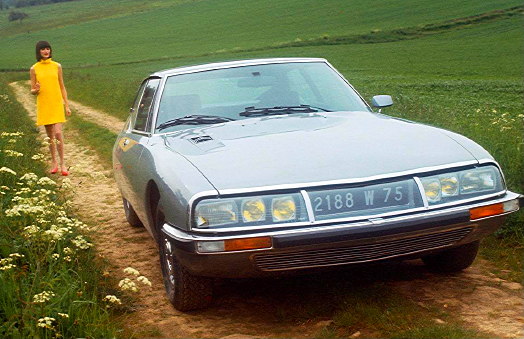Citroën started thinking about adding a luxury car to its range in the mid-1960s, perhaps with one eye on the market left vacant by the collapse of Facel Vega in 1964. Facels had been powered by enormous Chrysler V8s, but French tax law now made anything larger than a ‘15CV’ (equivalent to about 2.8-litres) virtually unsaleable. So Citroën enlisted help from Maserati to design and build a relatively small, but high-performance, V6 engine. A technical agreement with the
Maserati came up with an all-alloy 2.7-litre V6. It’s often referred to as three-quarters of a Maserati V8, though according to Citroën specialist and SM owner Stuart Agar, if there is a relationship it’s a tenuous one as few parts are interchangeable between the two engines.
Source of the rumour is the SM V6’s 90 degree angle between the cylinder banks, unusual for a V6 but normal for a V8. It seems likely that the wider angle was used to reduce the height of the engine, in turn helping to keep the bonnet line low.
1972 Citroën SM Specifications
Engine 2670cc, 90 degree V6
Power 178bhp @ 5500rpm
Torque 164lbft @ 4000rpm
Transmission Five-speed manual, front-wheel drive
Suspension Hydropneumatic
Brakes Disc all round, power assisted
Wheels 6x15 steel
Tyres 195/70VR15
Performance Top Speed: 135mph, 0-60mph: 9.0sec
Striking looks and efficient aerodynamics were both parts of Citroën’s plan. The SM’s steel monocoque body was wide and low, with a teardrop taper in plan view that meant the rear track had to be nearly 6in narrower than the front. Underneath there was a development of Citroën’s hydropneumatic suspension system, familiar from the DS. At the back the wheels were suspended from DS-style trailing arms, but the front wheels were mounted on unequal length transverse arms. Where the trailing arms forced the wheels to roll to the same angle as the body, compromising grip, the new transverse links kept the SM’s front wheels vertical as the body rolled to minimise understeer and maximise traction.
As with the DS, the powered hydraulic system was used not just to maintain the car’s ride height, but also to level the headlights (and steer the inner lamps into corners), to power the brakes and to provide effortless steering. With just two turns between locks the steering was very direct, but the combination of power assistance and zero steering offset made it so ‘irreversible’ in its response that Citroën said even a burst front tyre would not cause the wheel to fight in the driver’s hands. To give the driver more confidence at speed, artificial ‘feel’ was engineered into the system.
The SM managed to blend high levels of grip with an excellent ride, though in usual Citroën style the car assumed large roll angles in fast corners. Road surface irregularities did little to worry the SM, and at high speed the car’s sophisticated aerodynamics made it stable and secure. It was a fine open-road cruiser.
Nothing can prepare you for driving the SM. The long door opens onto an inviting cabin with multi-adjustable leather-clad hammock seats and chrome-plated fittings. The single-spoke steering wheel is typical Citroën, and ahead of it sit an oval speedo and tacho, together with a group of warning lights in a matching oval cluster.
The chrome gearlever has a precise action, the clutch quite a heavy one. Noise is subdued at low speeds, but as the revs rise the Maserati engine makes it presence felt – the V6 snarl a little at odds with the SM’s calmness. The steering is, well, curious: no kickback, no real feel, finger-light when manoeuvring but quite hefty at speed. The strong brakes are operated by a rubber button on the floor which responds to pressure rather than movement. It’s all very alien, but put aside your prejudices and you realise that the SM goes rather well. Performance is strong, the ride excellent and well-damped, and the whole car gives off a sense of imperturbability. Get in tune with it and it’s very, very impressive.
